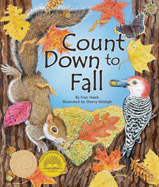Alignment to Standards for LA

| Grade | Number | Standard |
|---|---|---|
| 1 | LS-1.26 | Describe the differences between plants and animals |
| 1 | LS-1.32 | Describe features of some animals that benefit them in their environments |
| 1 | PS-1.13 | Sort a group of objects by using multiple characteristics |
| 1 | PS-1.17 | Sort and classify objects by their state of matter |
| 2 | LS-2.28 | Describe structures of plants (e.g., roots, leaves, stems, flowers, seeds) |
| 2 | LS-2.34 | Describe inherited characteristics of living things |
| 2 | SE-2.45 | Locate and identify plants and animals within an ecosystem |
| 3 | ESS-3.47 | Describe the difference between weather and climate |
| 3 | LS-3.35 | Compare structures (parts of the body) in a variety of animals (e.g., fish, mammals, reptiles, amphibians, birds, insects) |
| 3 | LS-3.36 | Compare structures (e.g., roots, leaves, stems, flowers, seeds) and their functions in a variety of plants |
| 3 | LS-3.37 | Describe how plant structures enable the plant to meet its basic needs |
| 3 | LS-3.38 | Classify groups of organisms based on common characteristics |
| 3 | LS-3.39 | Compare organisms from different groups (e.g., birds with mammals, terrestrial plants with aquatic plants) |
| 3 | SE-3.59 | Classify manufactured products according to the natural resources from which they are made (e.g., copper wire from copper ore, plastic from petroleum) |
| 4 | LS-4.40 | Explain the functions of plant structures in relation to their ability to make food through photosynthesis (e.g., roots, leaves, stems, flowers, seeds) |
| 4 | LS-4.41 | Describe how parts of animalsê bodies are related to their functions and survival (e.g., wings/flying, webbed feet/swimming) |
| 4 | LS-4.52 | Describe how some plants and animals have adapted to their habitats |
| 4 | LS-4.53 | Identify the habitat in which selected organisms would most likely live and explain how specific structures help organisms to survive |
| 5 | LS-5.19. | Describe the processes of photosynthesis and respiration in green plants |
| 5 | PS-5.12. | Identify the Sun as Earthês primary energy source and give examples (e.g., photosynthesis, water cycle) to support that conclusion |
| K | ESS-K.31 | Identify the patterns in information recorded on a weather calendar |
| K | LS-K.25 | observable variations within types of plants and animals (e.g., features of classmates, varieties of trees, breeds of dogs) |
| K | PS-K.11. | Identify objects by using the senses |
| K | PS-K.13 | Sort objects based on their properties (e.g., size, weight, texture) |
| PK | LS-PK.20 | Give examples of different kinds of plants and different kinds of animals |
| PK | LS-PK.22. | Learn about animals and plants through nonfiction literature (For Creative Minds) |
| PK | PS-PK.9 | Sort objects using one characteristic |